sensor MAZDA MODEL 3 HATCHBACK 2006 (in English) User Guide
[x] Cancel search | Manufacturer: MAZDA, Model Year: 2006, Model line: MODEL 3 HATCHBACK, Model: MAZDA MODEL 3 HATCHBACK 2006Pages: 372, PDF Size: 5.55 MB
Page 61 of 372

Black plate (61,1)
The front passenger air bag deactivation indicator light illuminates or is off under the following conditions:
Total seated weight on the
front passenger seatFront passenger air bag
deactivation indicator lightFront passenger front and
side air bagsFront passenger seat
belt pretensioner
system
Empty (Not occupied)
*OFF OFF OFF
Less than approx. 30 kg
(66 lb)ON OFF OFF
Approx. 42 kg (93 lb) or
moreOFF ON ON
* If the front passenger seat belt is buckled, the front passenger air bag deactivation indicator light illuminates,
however this does not indicate a malfunction.
If the front passenger air bag deactivation indicator light does not illuminate when the
ignition switch is turned to the ON position and does not illuminate as indicated in the
above chart, do not allow a child to sit in the front passenger seat and consult an
Authorized Mazda Dealer as soon as possible. The system may not work properly in an
accident.
WARNING
Decreasing the Total Seated Weight on the Front Passenger Seat:
When an adult or large child sits on the front passenger seat, decreasing the total
seated weight on the front passenger seat from the total seated weight of
approximately 42 kg (93 lb) required for air bag deployment is dangerous. The front
passenger seat weight sensors will detect the reduced total seated weight condition and
the front passenger front and side air bags and seat belt pretensioner system will not
deploy during an accident. The front passenger will not have the supplementary
protection of the air bag, which could result in serious injury. Decreasing the total
seated weight on the front passenger seat from the total seated weight of
approximately 42 kg (93 lb) could result in an air bag not deploying under the
following conditions, for example:
lA rear passenger pushes up on the front passenger seat with the feet.lLuggage or other items placed under the front passenger seat or between the front
passenger seat and driver seat that push up the front passenger seat bottom.
lThe front passenger seat occupant sits in a manner that does not place the entire
weight of the occupant on the seat such as by sitting too close to the door, grasping
the rim of the moonroof and sitting with the seatback reclined too far.
lAny accessories which might decrease the total seated weight on the front
passenger seat are attached to the front passenger seat.
The front passenger front and side air bags and seat belt pretensioner systems will
deactivate if the total seated weight on the front passenger seat is close to 30 kg (66 lb)
and they will reactivate before the weight exceeds 42 kg (93 lb).
Essential Safety Equipment
SRS Air Bags
2-47
Mazda3_8U55-EA-05G_Edition2 Page61
Thursday, June 23 2005 2:53 PM
Form No.8U55-EA-05G
Page 62 of 372
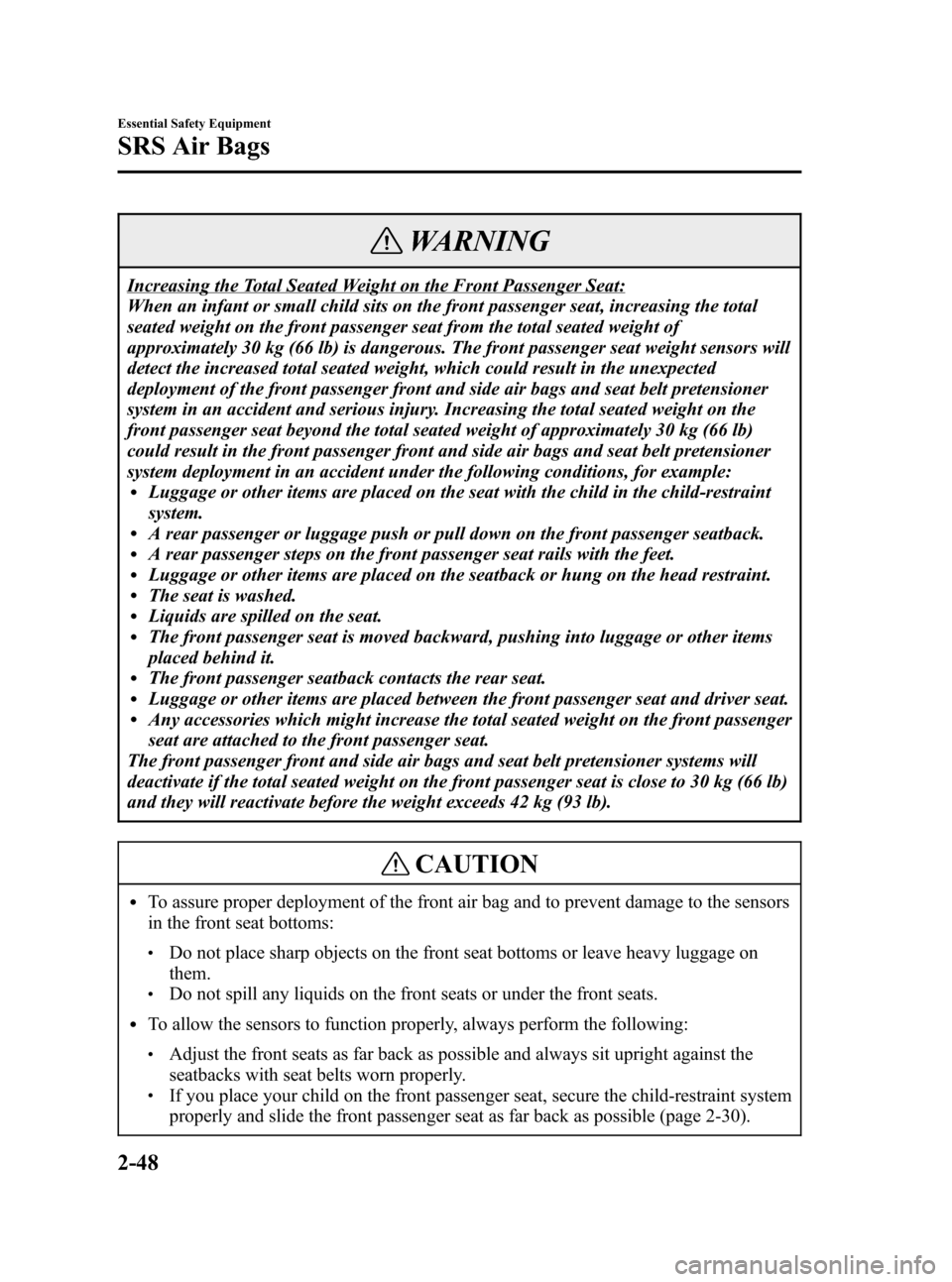
Black plate (62,1)
WARNING
Increasing the Total Seated Weight on the Front Passenger Seat:
When an infant or small child sits on the front passenger seat, increasing the total
seated weight on the front passenger seat from the total seated weight of
approximately 30 kg (66 lb) is dangerous. The front passenger seat weight sensors will
detect the increased total seated weight, which could result in the unexpected
deployment of the front passenger front and side air bags and seat belt pretensioner
system in an accident and serious injury. Increasing the total seated weight on the
front passenger seat beyond the total seated weight of approximately 30 kg (66 lb)
could result in the front passenger front and side air bags and seat belt pretensioner
system deployment in an accident under the following conditions, for example:
lLuggage or other items are placed on the seat with the child in the child-restraint
system.
lA rear passenger or luggage push or pull down on the front passenger seatback.lA rear passenger steps on the front passenger seat rails with the feet.lLuggage or other items are placed on the seatback or hung on the head restraint.lThe seat is washed.lLiquids are spilled on the seat.lThe front passenger seat is moved backward, pushing into luggage or other items
placed behind it.
lThe front passenger seatback contacts the rear seat.lLuggage or other items are placed between the front passenger seat and driver seat.lAny accessories which might increase the total seated weight on the front passenger
seat are attached to the front passenger seat.
The front passenger front and side air bags and seat belt pretensioner systems will
deactivate if the total seated weight on the front passenger seat is close to 30 kg (66 lb)
and they will reactivate before the weight exceeds 42 kg (93 lb).
CAUTION
lTo assure proper deployment of the front air bag and to prevent damage to the sensors
in the front seat bottoms:
lDo not place sharp objects on the front seat bottoms or leave heavy luggage on
them.
lDo not spill any liquids on the front seats or under the front seats.
lTo allow the sensors to function properly, always perform the following:
lAdjust the front seats as far back as possible and always sit upright against the
seatbacks with seat belts worn properly.
lIf you place your child on the front passenger seat, secure the child-restraint system
properly and slide the front passenger seat as far back as possible (page 2-30).
2-48
Essential Safety Equipment
SRS Air Bags
Mazda3_8U55-EA-05G_Edition2 Page62
Thursday, June 23 2005 2:53 PM
Form No.8U55-EA-05G
Page 63 of 372

Black plate (63,1)
NOTE
lThe system requires about 10 seconds to alternate between turning the front passenger
front and side air bags and seat belt pretensioner system on or off.
lThe front passenger air bag deactivation indicator light may illuminate repeatedly if
luggage or other items are put on the front passenger seat, or if the temperature of the
vehicle's interior changes suddenly.
lThe front passenger air bag deactivation indicator light may illuminate for 10 seconds
if the total seated weight on the front passenger seat changes.
lIf the front passenger air bag deactivation indicator light does not illuminate after
installing a child-restraint system on the front passenger seat, install the child-restraint
system on the rear seat and consult an Authorized Mazda Dealer as soon as possible.
Driver and front passenger buckle switches
The buckle switches on the front seat belts detect whether or not the front seat belts are
securely fastened and further control the deployment of the air bags.
qHow the Side and Curtain Air Bags Workí
When air bag crash sensors detect a side impact of greater than moderate force, an
electrical current is sent to the inflators.
Gases are produced to inflate the side and curtain air bags and after the inflation, the side
and curtain air bags quickly deflate.
The side and curtain air bags will function only once. After that,the side and curtain air
bags will not work again and must be replaced.Only an Authorized Mazda Dealer can
replace the systems.
The side and curtain air bags will deploy only on the
side the vehicle receives the force of the impact.
Essential Safety Equipment
SRS Air Bags
2-49íSome models. Mazda3_8U55-EA-05G_Edition2 Page63
Thursday, June 23 2005 2:53 PM
Form No.8U55-EA-05G
Page 64 of 372

Black plate (64,1)
WARNING
Damaged Side and Curtain Air Bag Wiring under the Front Seats:
Placing luggage or other objects under the front seats is dangerous. The side and
curtain air bag wiring could be damaged, and in the event of a side collision, the side
and curtain air bags may not deploy, which could result in death or serious injury. To
prevent damage to the side and curtain air bag wiring, do not place luggage or other
objects under the front seats.
qAir Bag Activation/Deactivation
NOTE
If the front passenger seat weight sensors detect a total seated weight on the front
passenger seat is less than approximately 42 kg (93 lb), the front passenger front and side
air bags and seat belt pretensioner may not inflate (page 2-45).
Front air bag activation
A greater than moderate impact will cause
the front air bags to inflate in the
following cases:
lHitting a solid wall straight on at
greater than about 22 km/h (14 mph).
lHitting a curb, pavement edge or hard
object.
lLanding hard or the vehicle falling.
lFrontal impact within about a 30
degree range from head-on to the
vehicle.
2-50
Essential Safety Equipment
SRS Air Bags
Mazda3_8U55-EA-05G_Edition2 Page64
Thursday, June 23 2005 2:53 PM
Form No.8U55-EA-05G
Page 67 of 372
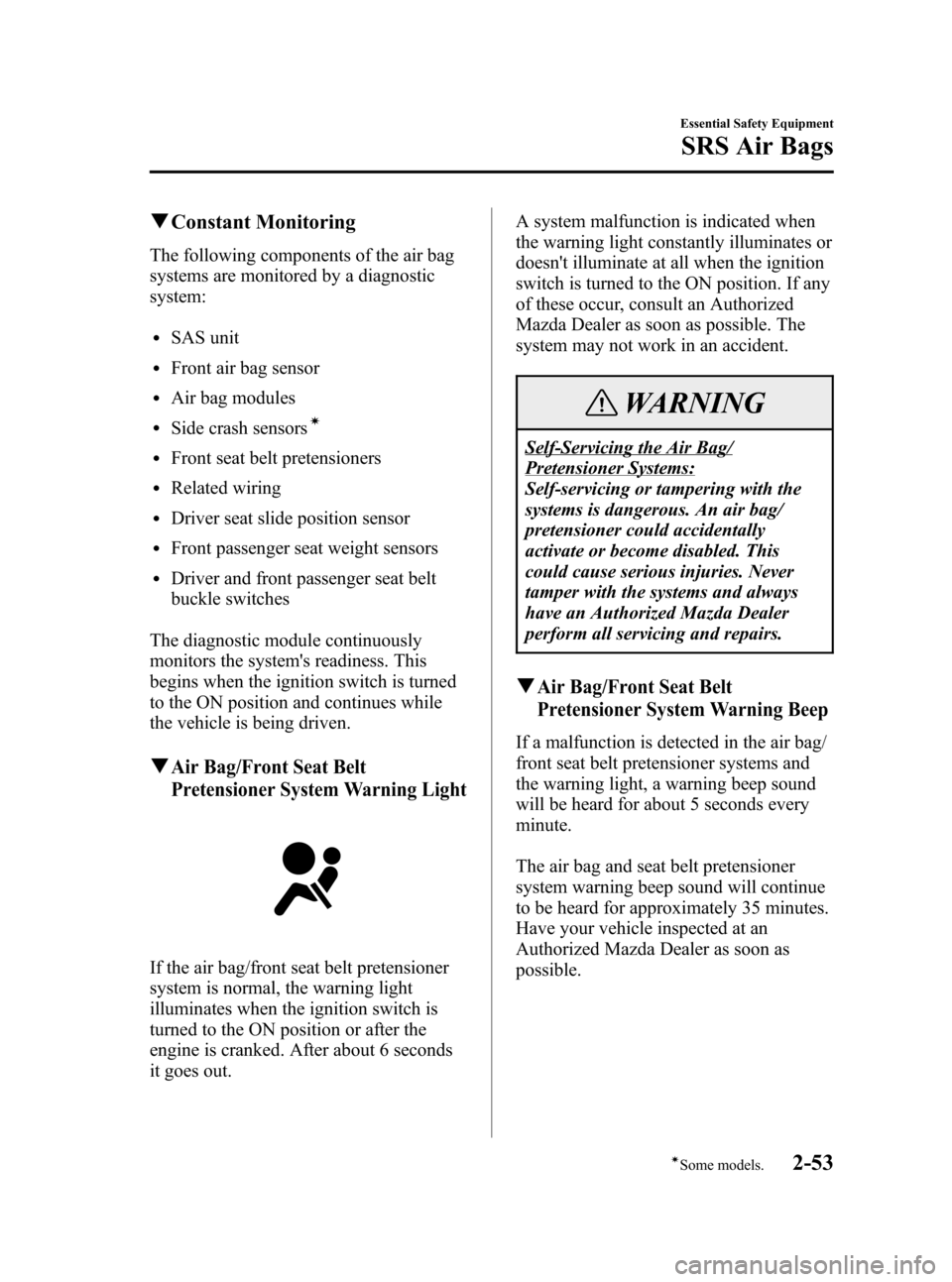
Black plate (67,1)
qConstant Monitoring
The following components of the air bag
systems are monitored by a diagnostic
system:
lSAS unit
lFront air bag sensor
lAir bag modules
lSide crash sensorsí
lFront seat belt pretensioners
lRelated wiring
lDriver seat slide position sensor
lFront passenger seat weight sensors
lDriver and front passenger seat belt
buckle switches
The diagnostic module continuously
monitors the system's readiness. This
begins when the ignition switch is turned
to the ON position and continues while
the vehicle is being driven.
qAir Bag/Front Seat Belt
Pretensioner System Warning Light
If the air bag/front seat belt pretensioner
system is normal, the warning light
illuminates when the ignition switch is
turned to the ON position or after the
engine is cranked. After about 6 seconds
it goes out.A system malfunction is indicated when
the warning light constantly illuminates or
doesn't illuminate at all when the ignition
switch is turned to the ON position. If any
of these occur, consult an Authorized
Mazda Dealer as soon as possible. The
system may not work in an accident.
WARNING
Self-Servicing the Air Bag/
Pretensioner Systems:
Self-servicing or tampering with the
systems is dangerous. An air bag/
pretensioner could accidentally
activate or become disabled. This
could cause serious injuries. Never
tamper with the systems and always
have an Authorized Mazda Dealer
perform all servicing and repairs.
qAir Bag/Front Seat Belt
Pretensioner System Warning Beep
If a malfunction is detected in the air bag/
front seat belt pretensioner systems and
the warning light, a warning beep sound
will be heard for about 5 seconds every
minute.
The air bag and seat belt pretensioner
system warning beep sound will continue
to be heard for approximately 35 minutes.
Have your vehicle inspected at an
Authorized Mazda Dealer as soon as
possible.
Essential Safety Equipment
SRS Air Bags
2-53íSome models. Mazda3_8U55-EA-05G_Edition2 Page67
Thursday, June 23 2005 2:53 PM
Form No.8U55-EA-05G
Page 68 of 372
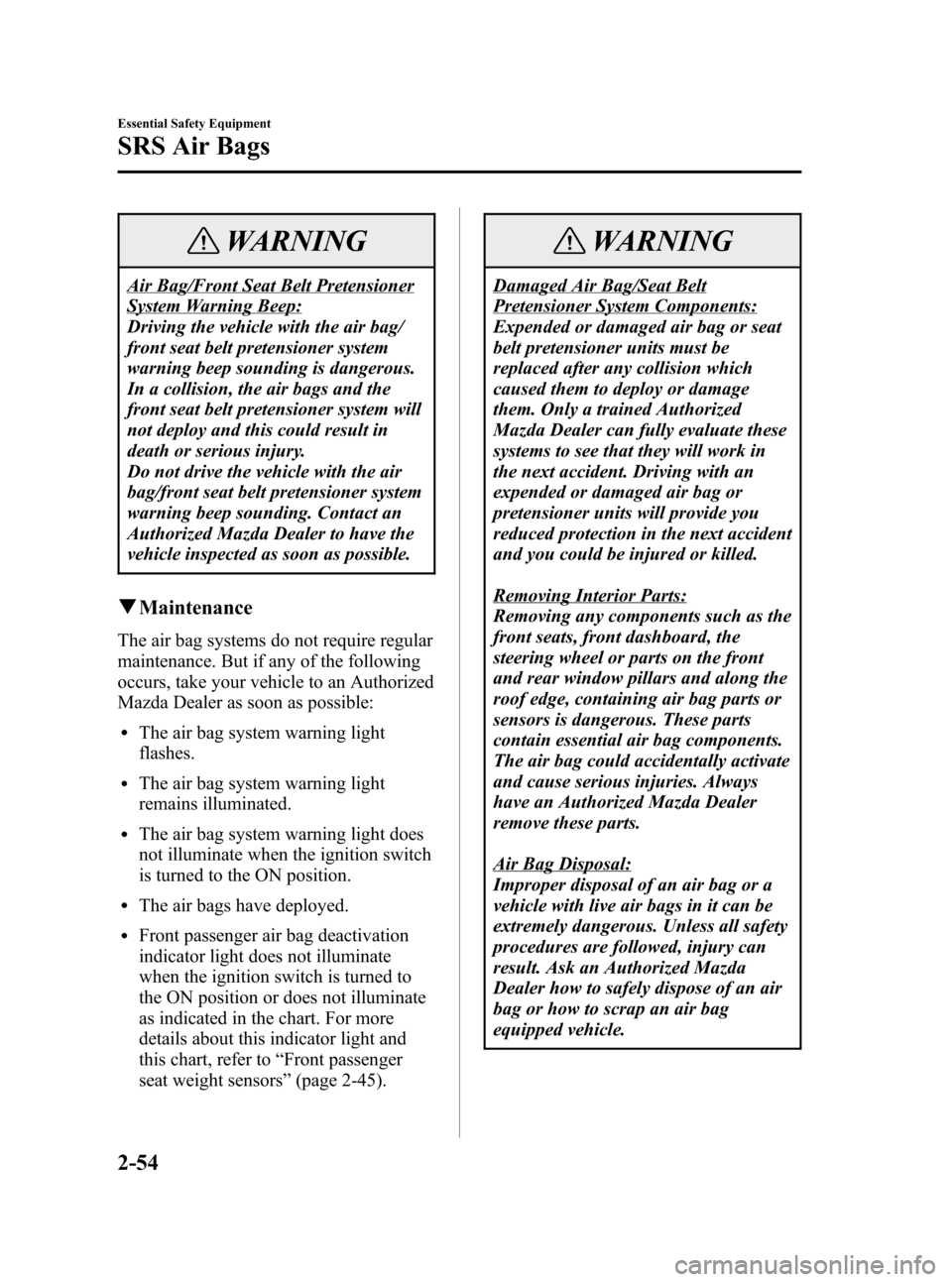
Black plate (68,1)
WARNING
Air Bag/Front Seat Belt Pretensioner
System Warning Beep:
Driving the vehicle with the air bag/
front seat belt pretensioner system
warning beep sounding is dangerous.
In a collision, the air bags and the
front seat belt pretensioner system will
not deploy and this could result in
death or serious injury.
Do not drive the vehicle with the air
bag/front seat belt pretensioner system
warning beep sounding. Contact an
Authorized Mazda Dealer to have the
vehicle inspected as soon as possible.
qMaintenance
The air bag systems do not require regular
maintenance. But if any of the following
occurs, take your vehicle to an Authorized
Mazda Dealer as soon as possible:
lThe air bag system warning light
flashes.
lThe air bag system warning light
remains illuminated.
lThe air bag system warning light does
not illuminate when the ignition switch
is turned to the ON position.
lThe air bags have deployed.
lFront passenger air bag deactivation
indicator light does not illuminate
when the ignition switch is turned to
the ON position or does not illuminate
as indicated in the chart. For more
details about this indicator light and
this chart, refer to“Front passenger
seat weight sensors”(page 2-45).
WARNING
Damaged Air Bag/Seat Belt
Pretensioner System Components:
Expended or damaged air bag or seat
belt pretensioner units must be
replaced after any collision which
caused them to deploy or damage
them. Only a trained Authorized
Mazda Dealer can fully evaluate these
systems to see that they will work in
the next accident. Driving with an
expended or damaged air bag or
pretensioner units will provide you
reduced protection in the next accident
and you could be injured or killed.
Removing Interior Parts:
Removing any components such as the
front seats, front dashboard, the
steering wheel or parts on the front
and rear window pillars and along the
roof edge, containing air bag parts or
sensors is dangerous. These parts
contain essential air bag components.
The air bag could accidentally activate
and cause serious injuries. Always
have an Authorized Mazda Dealer
remove these parts.
Air Bag Disposal:
Improper disposal of an air bag or a
vehicle with live air bags in it can be
extremely dangerous. Unless all safety
procedures are followed, injury can
result. Ask an Authorized Mazda
Dealer how to safely dispose of an air
bag or how to scrap an air bag
equipped vehicle.
2-54
Essential Safety Equipment
SRS Air Bags
Mazda3_8U55-EA-05G_Edition2 Page68
Thursday, June 23 2005 2:53 PM
Form No.8U55-EA-05G
Page 102 of 372
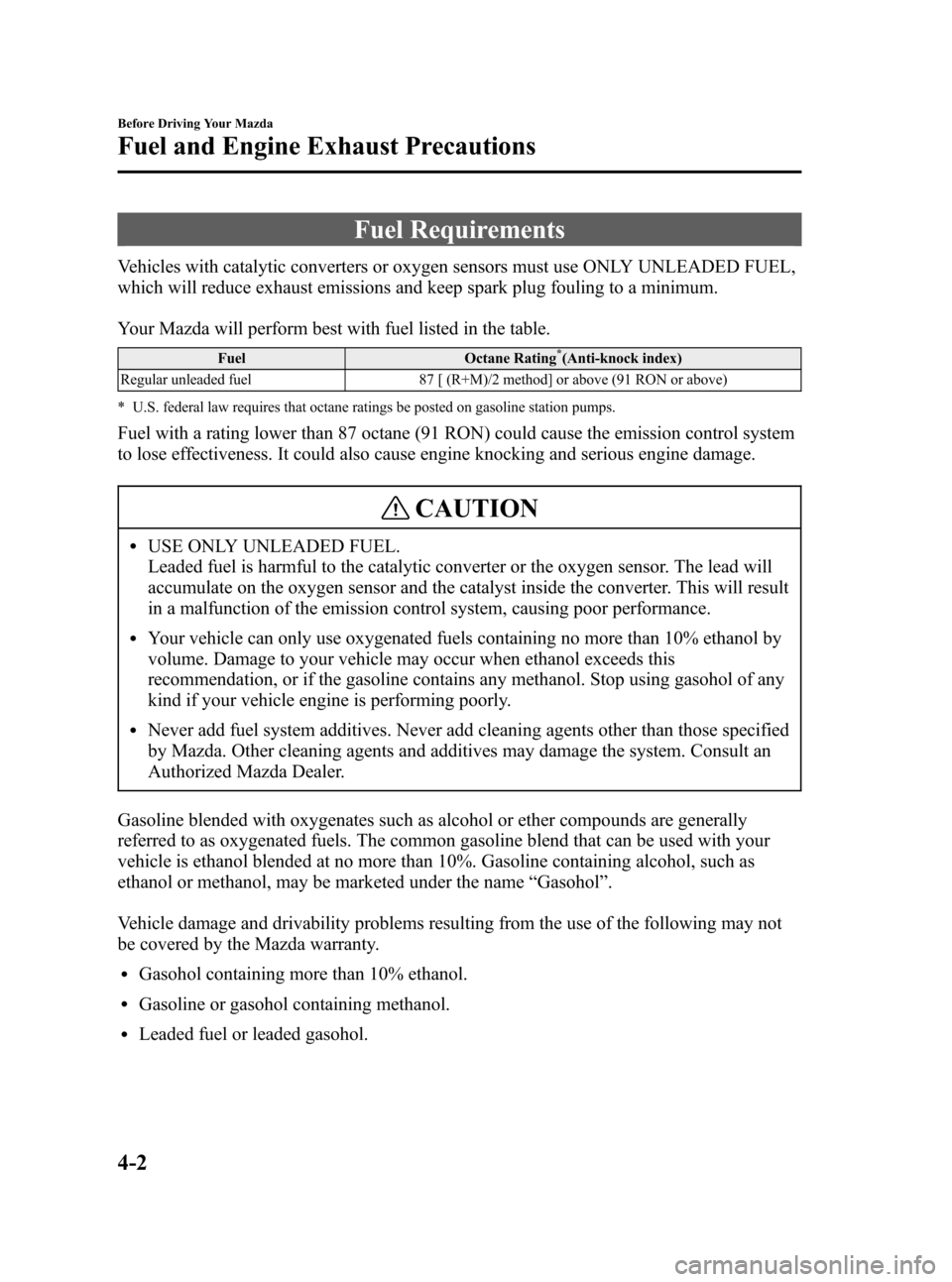
Black plate (102,1)
Fuel Requirements
Vehicles with catalytic converters or oxygen sensors must use ONLY UNLEADED FUEL,
which will reduce exhaust emissions and keep spark plug fouling to a minimum.
Your Mazda will perform best with fuel listed in the table.
Fuel Octane Rating*(Anti-knock index)
Regular unleaded fuel 87 [ (R+M)/2 method] or above (91 RON or above)
* U.S. federal law requires that octane ratings be posted on gasoline station pumps.
Fuel with a rating lower than 87 octane (91 RON) could cause the emission control system
to lose effectiveness. It could also cause engine knocking and serious engine damage.
CAUTION
lUSE ONLY UNLEADED FUEL.
Leaded fuel is harmful to the catalytic converter or the oxygen sensor. The lead will
accumulate on the oxygen sensor and the catalyst inside the converter. This will result
in a malfunction of the emission control system, causing poor performance.
lYour vehicle can only use oxygenated fuels containing no more than 10% ethanol by
volume. Damage to your vehicle may occur when ethanol exceeds this
recommendation, or if the gasoline contains any methanol. Stop using gasohol of any
kind if your vehicle engine is performing poorly.
lNever add fuel system additives. Never add cleaning agents other than those specified
by Mazda. Other cleaning agents and additives may damage the system. Consult an
Authorized Mazda Dealer.
Gasoline blended with oxygenates such as alcohol or ether compounds are generally
referred to as oxygenated fuels. The common gasoline blend that can be used with your
vehicle is ethanol blended at no more than 10%. Gasoline containing alcohol, such as
ethanol or methanol, may be marketed under the name“Gasohol”.
Vehicle damage and drivability problems resulting from the use of the following may not
be covered by the Mazda warranty.
lGasohol containing more than 10% ethanol.
lGasoline or gasohol containing methanol.
lLeaded fuel or leaded gasohol.
4-2
Before Driving Your Mazda
Fuel and Engine Exhaust Precautions
Mazda3_8U55-EA-05G_Edition2 Page102
Thursday, June 23 2005 2:53 PM
Form No.8U55-EA-05G
Page 136 of 372
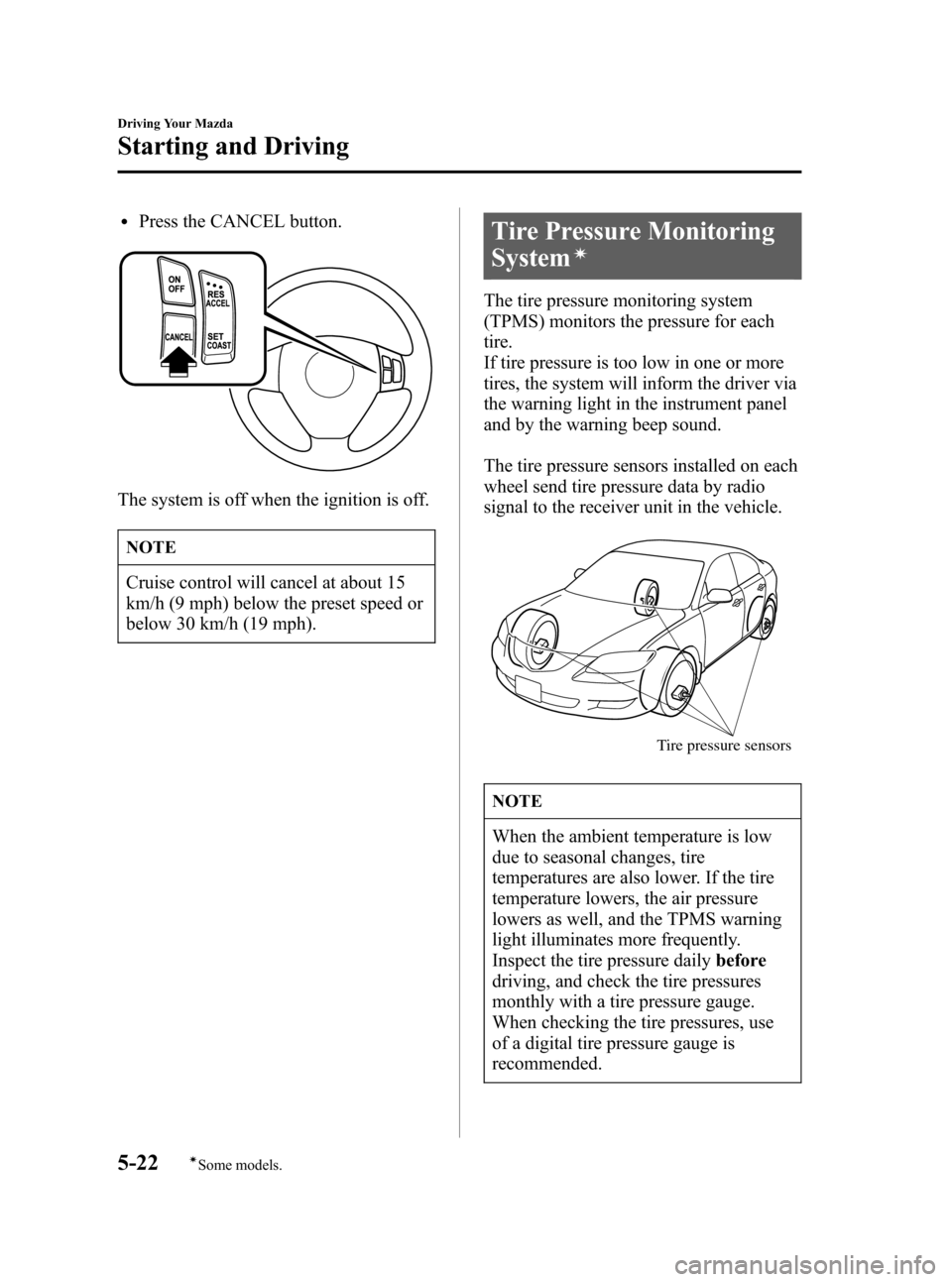
Black plate (136,1)
lPress the CANCEL button.
The system is off when the ignition is off.
NOTE
Cruise control will cancel at about 15
km/h (9 mph) below the preset speed or
below 30 km/h (19 mph).
Tire Pressure Monitoring
System
í
The tire pressure monitoring system
(TPMS) monitors the pressure for each
tire.
If tire pressure is too low in one or more
tires, the system will inform the driver via
the warning light in the instrument panel
and by the warning beep sound.
The tire pressure sensors installed on each
wheel send tire pressure data by radio
signal to the receiver unit in the vehicle.
Tire pressure sensors
NOTE
When the ambient temperature is low
due to seasonal changes, tire
temperatures are also lower. If the tire
temperature lowers, the air pressure
lowers as well, and the TPMS warning
light illuminates more frequently.
Inspect the tire pressure dailybefore
driving, and check the tire pressures
monthly with a tire pressure gauge.
When checking the tire pressures, use
of a digital tire pressure gauge is
recommended.
5-22
Driving Your Mazda
íSome models.
Starting and Driving
Mazda3_8U55-EA-05G_Edition2 Page136
Thursday, June 23 2005 2:53 PM
Form No.8U55-EA-05G
Page 138 of 372
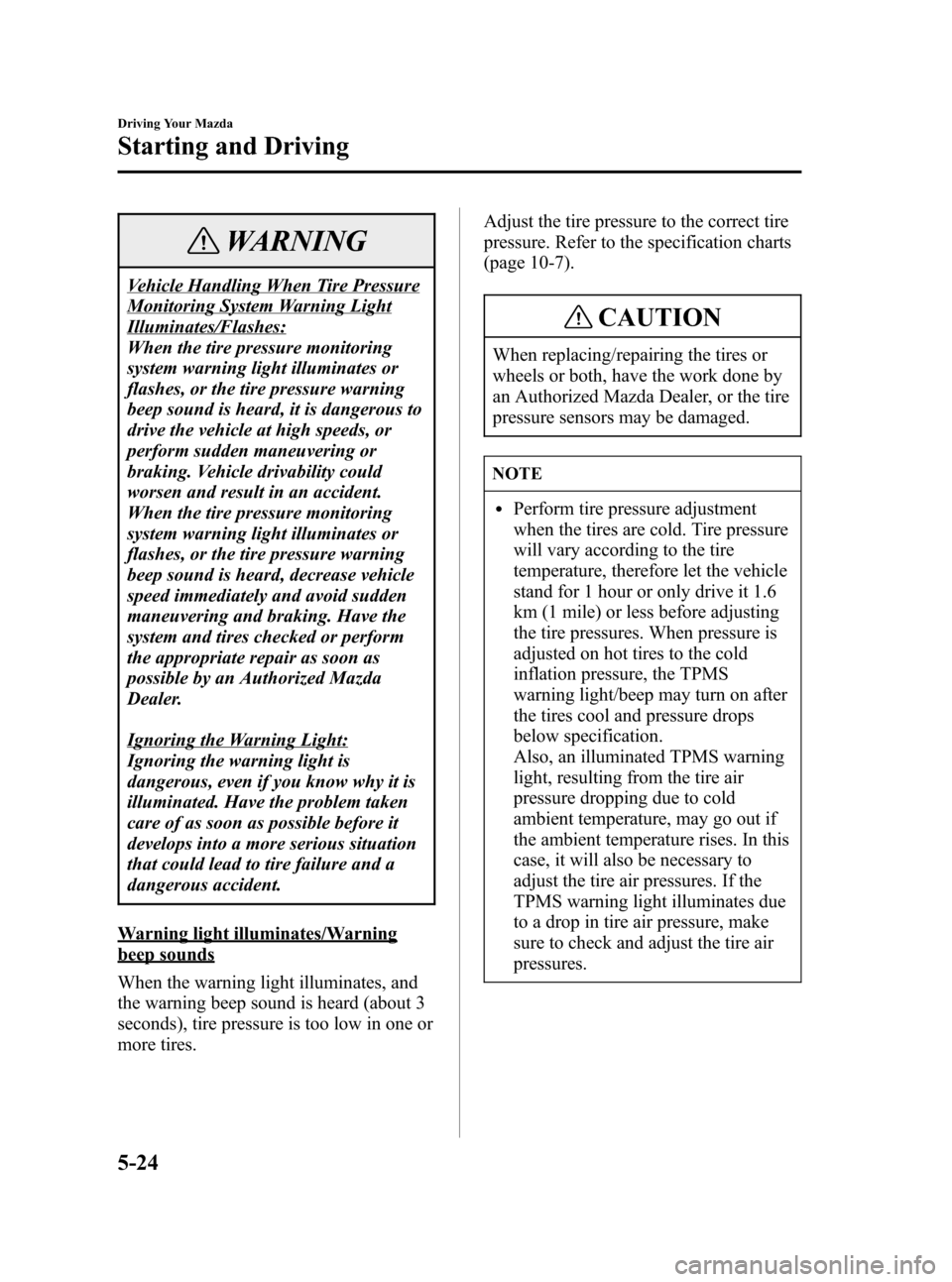
Black plate (138,1)
WARNING
Vehicle Handling When Tire Pressure
Monitoring System Warning Light
Illuminates/Flashes:
When the tire pressure monitoring
system warning light illuminates or
flashes, or the tire pressure warning
beep sound is heard, it is dangerous to
drive the vehicle at high speeds, or
perform sudden maneuvering or
braking. Vehicle drivability could
worsen and result in an accident.
When the tire pressure monitoring
system warning light illuminates or
flashes, or the tire pressure warning
beep sound is heard, decrease vehicle
speed immediately and avoid sudden
maneuvering and braking. Have the
system and tires checked or perform
the appropriate repair as soon as
possible by an Authorized Mazda
Dealer.
Ignoring the Warning Light:
Ignoring the warning light is
dangerous, even if you know why it is
illuminated. Have the problem taken
care of as soon as possible before it
develops into a more serious situation
that could lead to tire failure and a
dangerous accident.
Warning light illuminates/Warning
beep sounds
When the warning light illuminates, and
the warning beep sound is heard (about 3
seconds), tire pressure is too low in one or
more tires.Adjust the tire pressure to the correct tire
pressure. Refer to the specification charts
(page 10-7).
CAUTION
When replacing/repairing the tires or
wheels or both, have the work done by
an Authorized Mazda Dealer, or the tire
pressure sensors may be damaged.
NOTE
lPerform tire pressure adjustment
when the tires are cold. Tire pressure
will vary according to the tire
temperature, therefore let the vehicle
stand for 1 hour or only drive it 1.6
km (1 mile) or less before adjusting
the tire pressures. When pressure is
adjusted on hot tires to the cold
inflation pressure, the TPMS
warning light/beep may turn on after
the tires cool and pressure drops
below specification.
Also, an illuminated TPMS warning
light, resulting from the tire air
pressure dropping due to cold
ambient temperature, may go out if
the ambient temperature rises. In this
case, it will also be necessary to
adjust the tire air pressures. If the
TPMS warning light illuminates due
to a drop in tire air pressure, make
sure to check and adjust the tire air
pressures.
5-24
Driving Your Mazda
Starting and Driving
Mazda3_8U55-EA-05G_Edition2 Page138
Thursday, June 23 2005 2:53 PM
Form No.8U55-EA-05G
Page 139 of 372
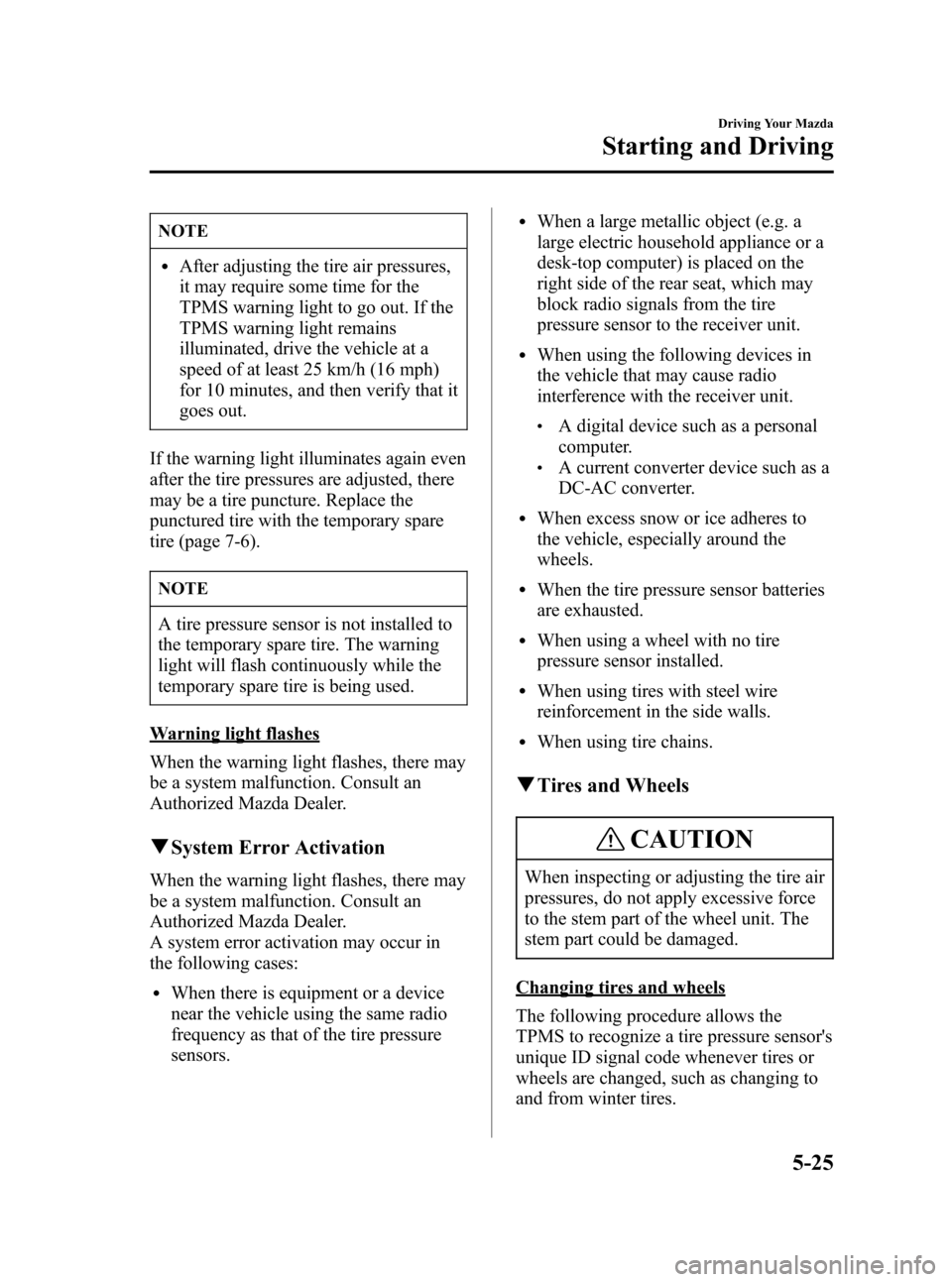
Black plate (139,1)
NOTE
lAfter adjusting the tire air pressures,
it may require some time for the
TPMS warning light to go out. If the
TPMS warning light remains
illuminated, drive the vehicle at a
speed of at least 25 km/h (16 mph)
for 10 minutes, and then verify that it
goes out.
If the warning light illuminates again even
after the tire pressures are adjusted, there
may be a tire puncture. Replace the
punctured tire with the temporary spare
tire (page 7-6).
NOTE
A tire pressure sensor is not installed to
the temporary spare tire. The warning
light will flash continuously while the
temporary spare tire is being used.
Warning light flashes
When the warning light flashes, there may
be a system malfunction. Consult an
Authorized Mazda Dealer.
qSystem Error Activation
When the warning light flashes, there may
be a system malfunction. Consult an
Authorized Mazda Dealer.
A system error activation may occur in
the following cases:
lWhen there is equipment or a device
near the vehicle using the same radio
frequency as that of the tire pressure
sensors.
lWhen a large metallic object (e.g. a
large electric household appliance or a
desk-top computer) is placed on the
right side of the rear seat, which may
block radio signals from the tire
pressure sensor to the receiver unit.
lWhen using the following devices in
the vehicle that may cause radio
interference with the receiver unit.
lA digital device such as a personal
computer.
lA current converter device such as a
DC-AC converter.
lWhen excess snow or ice adheres to
the vehicle, especially around the
wheels.
lWhen the tire pressure sensor batteries
are exhausted.
lWhen using a wheel with no tire
pressure sensor installed.
lWhen using tires with steel wire
reinforcement in the side walls.
lWhen using tire chains.
qTires and Wheels
CAUTION
When inspecting or adjusting the tire air
pressures, do not apply excessive force
to the stem part of the wheel unit. The
stem part could be damaged.
Changing tires and wheels
The following procedure allows the
TPMS to recognize a tire pressure sensor's
unique ID signal code whenever tires or
wheels are changed, such as changing to
and from winter tires.
Driving Your Mazda
Starting and Driving
5-25
Mazda3_8U55-EA-05G_Edition2 Page139
Thursday, June 23 2005 2:53 PM
Form No.8U55-EA-05G